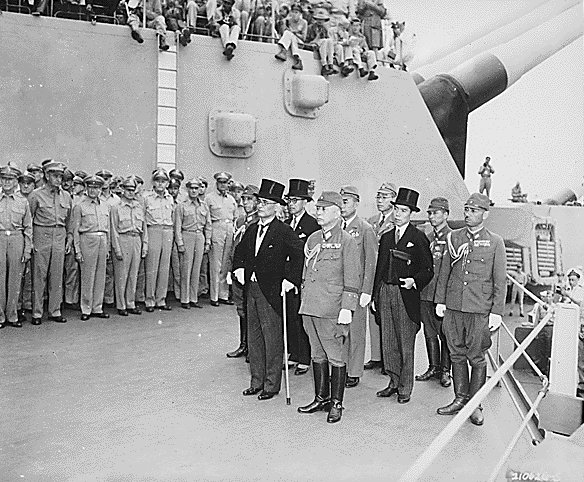 Victory over Japan Day
Victory over Japan Day2 September 1945 - 64 years ago
Victory over Japan Day (V-J Day, also known as Victory in the Pacific Day, or V-P Day) is a name chosen for the day on which the Surrender of Japan occurred, effectively ending World War II, and subsequent anniversaries of that event. The term has been applied to both the day on which the initial announcement of Japan's surrender was made in the afternoon of August 15, 1945 in Japan and to August 14, 1945 where it is observed as V-J Day in the United States when it was announced because of time zone differences in the Western Europe, the Americas, the Pacific Islands, and Australia and to September 2, 1945 when the formal signing of the surrender was made. The name V-J Day had been selected by the Allies after they named V-E Day for the victory in Europe.
Surrender
A little after noon Japan standard time on August 15, 1945, Emperor Hirohito's announcement of Japan's acceptance of the terms of the Potsdam Declaration was broadcast to the Japanese people over the radio. Earlier the same day, the Japanese government had broadcast an announcement over Radio Tokyo that "acceptance of the Potsdam Proclamation [would be] coming soon," and had advised the Allies of the surrender by sending a cable to U.S. President Harry S Truman via the Swiss diplomatic mission in Washington, D.C. On August 15 and 16 some Japanese soldiers, devastated by the surrender, committed suicide; over 100 American prisoners of war were also executed. In addition, many Australian and British prisoners of war were executed in Borneo, at both Ranau and Sandakan, by the Imperial Japanese Army.
Timeline
Surrender of Japan
July 29: Japan rejects the Potsdam Declaration.
August 2: Potsdam conference ends.
August 6: An atomic bomb, "Little Boy" is dropped on Hiroshima.
August 8: USSR declares war on Japan, operation of August Storm
August 9: Another atomic bomb, "Fat Man" is dropped on Nagasaki.
August 15: Japan surrenders. Date is remembered as "V-J Day" or "V-P Day" and described as such in newspapers in the United States, United Kingdom, Australia, New Zealand and Canada. That evening, General Frank Merrill announced, today is "B Day," the day on which peace talks would begin and occupation operations would be initiated.
September 2: Official surrender ceremony; President Truman declares September 2 officially "V-J Day".
March 1, 1946: Scheduled commencement of Operation Coronet, the allied invasion of Honshu.
Commemoration
China
September 3 is recognized as V-J Day in the People's Republic of China. As the final official surrender of Japan was accepted aboard the battleship USS Missouri in Tokyo Bay on September 2, 1945, the Kuomintang (KMT) government, which represented China on the Missouri, announced the three-day holidays to celebrate V-J Day, starting September 3. There are still "September 3" streets (in simplified Chinese: 九三街) and primary schools (in simplified Chinese: 九三小学) in almost every major city in China.
Korea
V-J Day is celebrated as "Liberation Day" in both of the Koreas since part of Japan's unconditional surrender included ending its rule over Korea.
United States
V-J Day is recognized as an official holiday only in the U.S. state of Rhode Island. The holiday's official name is "Victory Day", and it is observed on the second Monday of August. There have been several attempts in the 1980s and 1990s to eliminate or rename the holiday on the grounds that it is discriminatory. While those all failed, the state legislature did pass a resolution in 1990 "stating that Victory Day is not a day to express satisfaction in the destruction and death caused by nuclear bombs at Hiroshima and Nagasaki."




